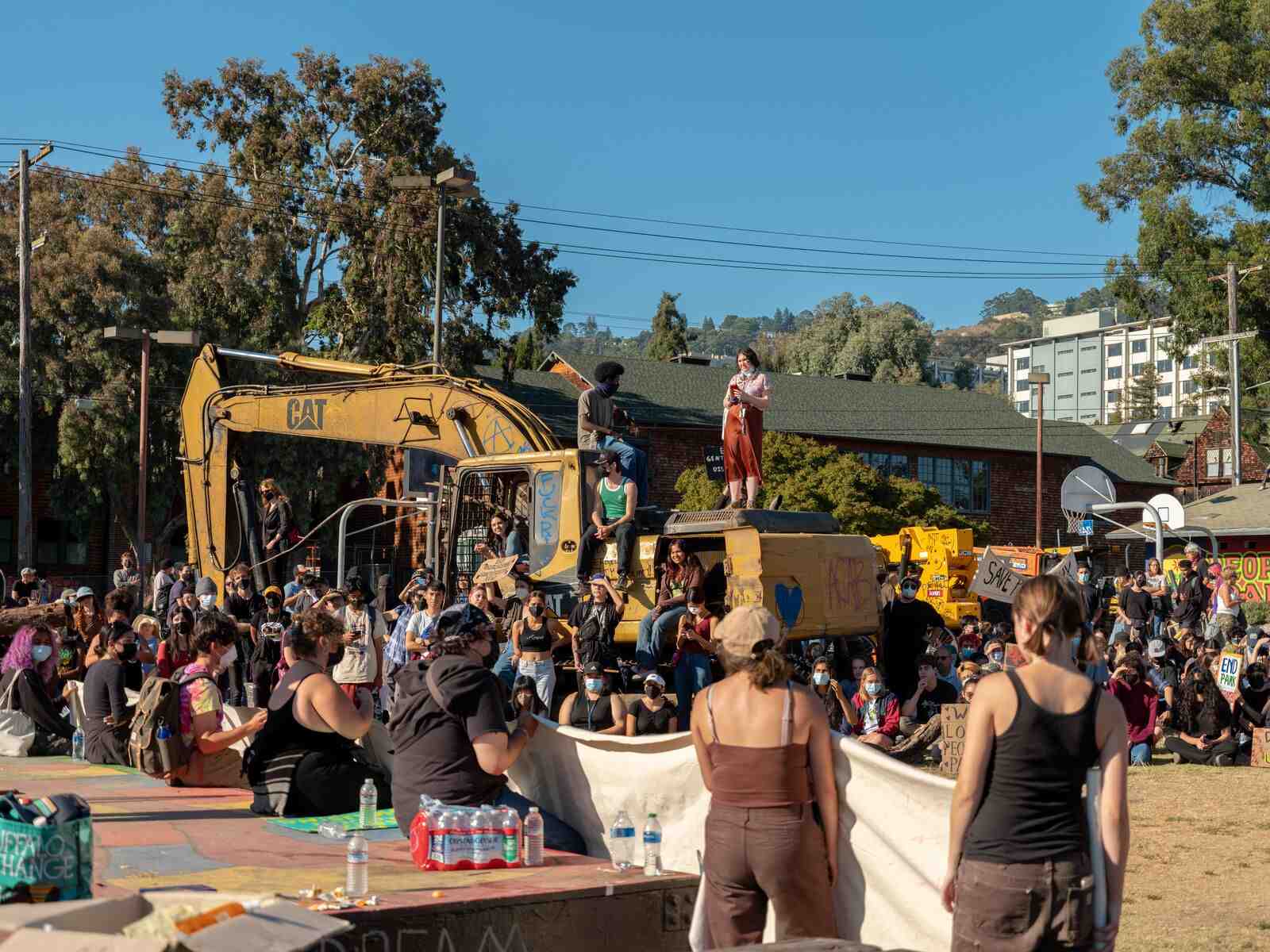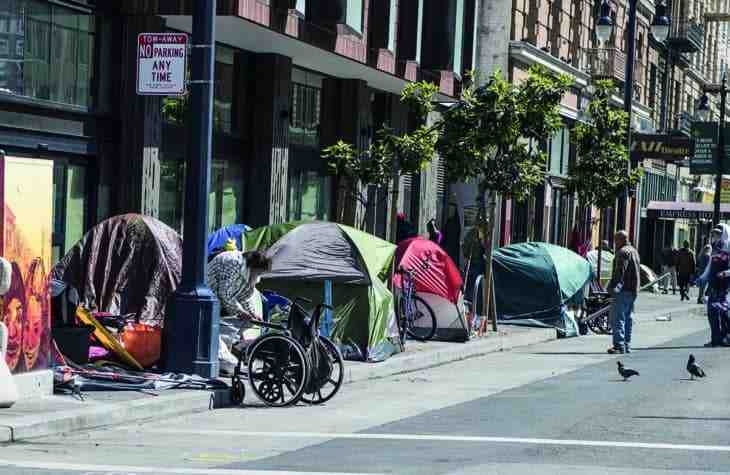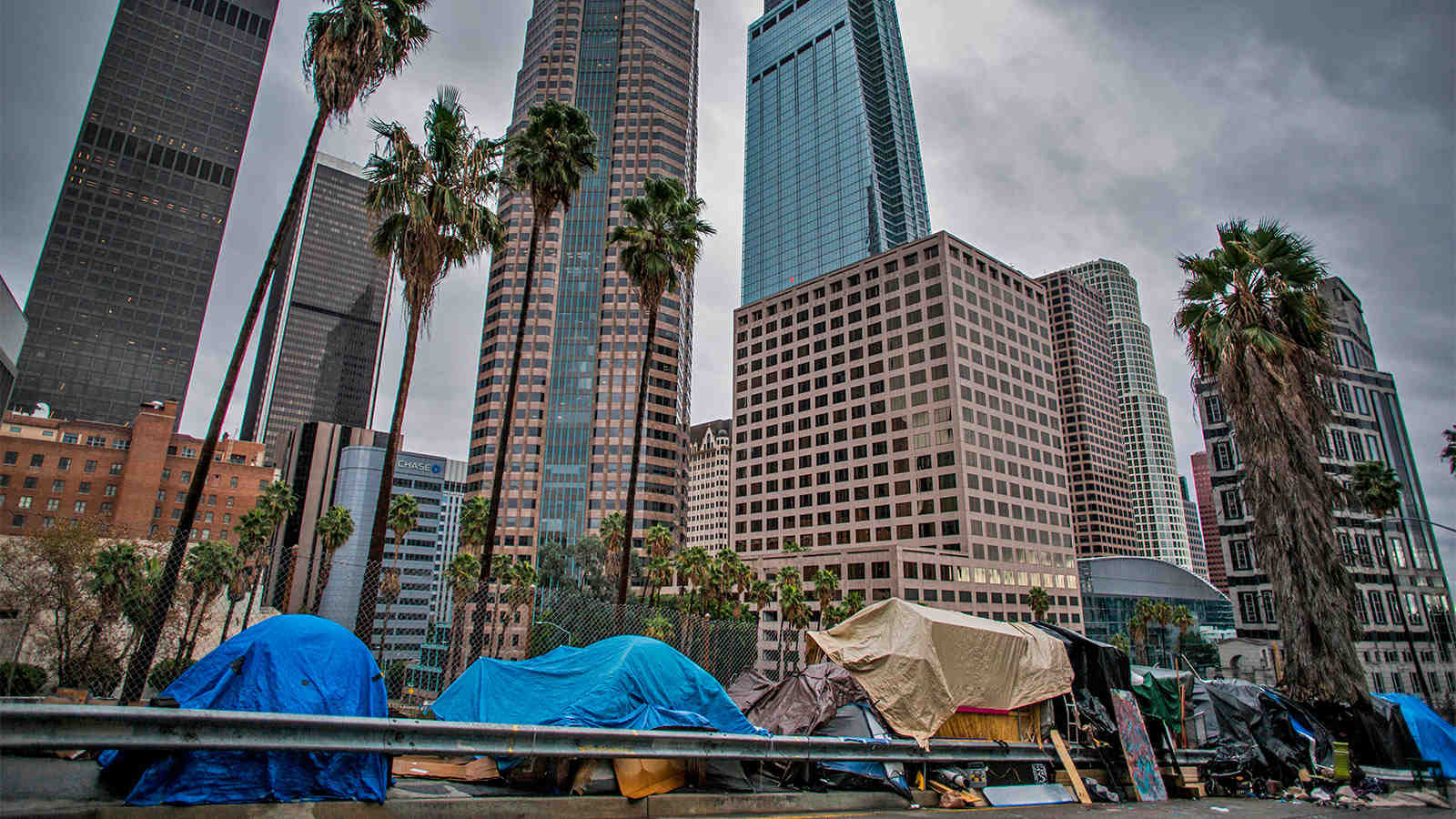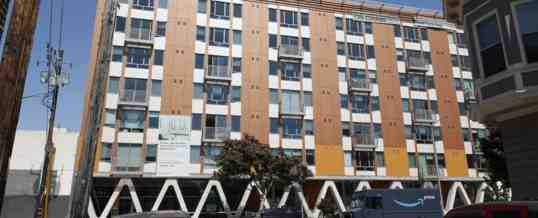A homeless man sits outside his tent on Venice Beach in Los Angeles on June 29, 2021. | Photo by Jae C. Hong/AP
SACRAMENTO, Calif. – On a hot summer day, a team of state workers arrived early to clear dozens of people camped out under a dusty overpass near the California Capitol. The campers gathered their tents, coolers and furniture and moved less than 100 feet across the street to the city-owned land where they had always been.
The city of Sacramento is taking a tougher stance on homeless encampments and is expected to begin enforcing a new ban on public camping by the end of the month — if the courts allow it.
As the pandemic recedes, elected officials across deep blue California are responding to intense public pressure to erase the most visible signs of homelessness. Democratic leaders, once reluctant to forcibly remove people from sidewalks, parks and highways, are increasingly enacting camping bans, often framing the policy as compassionate.
“Enforcement has its place,” said Sacramento Mayor Darrell Steinberg, a Democrat who spent much of the past year trying to calm public anger in a city where the number of unsheltered homeless people outnumbered San Francisco’s by 5,000 at last count. compared to 4,400 in San Francisco. “I think it’s okay for cities to say, ‘You know, there are certain places where it’s just not appropriate to camp.'”
Steinberg is one of many California Democrats who have long focused their efforts to end homelessness on services and shelters, but now find themselves supporting more punitive measures because the problem interferes with the public’s sense of peace and safety. That’s a staggering shift for a state where 113,000 people sleep outdoors each night, according to the latest statewide analysis released by the U.S. Department of Housing and Urban Development in 2020. California’s relatively mild climate allows for outdoor living year-round and more than half of the country’s homeless live here.
Democratic Gov. Gavin Newsom recently announced that the state had cleared 1,200 camps in the past year, trying to soften the message with a series of visits to social service programs. But because there aren’t enough beds to house the unhoused, advocates say efforts to clean up the camps are nothing more than cosmetic political gimmicks that essentially shift the problem from one street corner to another.
Steinberg, a liberal Democrat who has opposed forced removal until more shelters are available, has supported mental health and substance abuse programs for more than 20 years as ways to get people off the streets. But such programs have largely been unable to keep up with the growing number of homeless people in cities like Sacramento, where local leaders are now besieged by angry citizens demanding change.
He and many of his fellow Democratic mayors around the country are not averse to their cause. San Diego fined people who refuse asylum. Oakland increased its rate of camp closures as the pandemic eased. San Jose is scrambling to remove crowds from the area near the airport or risk losing federal funding.
“No one is happy to have to do this,” San Diego Mayor Todd Gloria said earlier this summer when discussing ticketing people who refuse asylum. “We’re doing everything we can to give people better options than the street.”
Other Democratic leaders across the country, facing similar pressure, have also moved to eliminate encampments and push the homeless out of public spaces. New York City Mayor Eric Adams, a former police captain who won office on a promise to fight crime, has come under fire this year for removing homeless people from subways and transit hubs. The city’s shelter system is now bursting at the seams.
In California, where the percentage of people living on the streets each day is much higher than in New York, the lack of shelter beds has caused friction and embroiled local and state officials in legal challenges.
A recent court ruling requires local authorities to provide enough beds before removing camps – a mandate that does not apply to state property. But that’s easier said than done in a country where there are three to four times more homeless people than shelter beds.
California’s homelessness problem has deep, knotty roots that go back decades, but has become increasingly prominent in recent years. Tents and tarps on sidewalks, in parks and under highways have become an almost ubiquitous symbol of the country’s ongoing crisis. A project to move people from camps to motels spurred by the pandemic failed and eviction moratoriums ended. Homelessness is the top concern of voters in the liberal state, and as Democrats prepare for the midterm elections, Newsom and other leaders are eager to show voters that they are taking action.
But clearing camps can be futile, especially when the people who are forced to pack up their tents have nowhere else to go or simply end up doing the same thing just a few blocks away.
Weeks after state transportation workers cleared a space under a Sacramento freeway, people are still camping on the city sidewalk across the street, with blankets, chairs, tires and shelves strewn across the street and sometimes blocking driveways.
Syeda Inamdar, owner of a small commercial building on the block, said her tenant is afraid to come to work because of the camp. A nearby Starbucks closed abruptly earlier this year due to safety concerns.
“It’s not safe for anyone,” said Inamdar, who sympathizes with the people in the camp but says she’s still considering giving up and selling the property.
Jay Edwards, a homeless man in his 60s, said he and many of his roommates feel safer under the overpass, where their tents don’t block the sidewalk and aren’t disturbed by people. Newsom and others have described living situations like his — in a blue tent, with a dirty mattress, surrounded by piles of random things and trash — as inhumane. Edwards disagreed.
“It’s not inhumane,” he said. “It’s inhumane because of people’s attitudes.”
The state has committed more than $12 billion in recent years to help local governments build housing and shelters. But it could be years before these units are built.
In Sacramento, city and county leaders just made it easier for authorities to clear tents from sidewalks and along the popular riverwalk. Some, however, want even stricter laws. Earlier this year, a coalition of Sacramento business owners approached city councilors in hopes of putting a measure on the November ballot that would force the city to move encampments that block sidewalks and create more shelter for those displaced. . The council, whose members run for office without party affiliation, voted the measure to the ballot with some caveats requiring the county’s help. Councilwoman Katie Valenzuela was one of two members who voted no.
She said moving the camps won’t help the root of the problem, and the city can’t afford the amount of space needed to house people who have been cleared from the camps.
“People say, ‘oh, you’ve got room for it, just put them all on 100 acres.’ That’s not how it works,” she said.
Newsom also seems to be feeling the pressure, channeling voter frustration by calling mass camps “unacceptable” and pointing to the trashed highway underpasses he clears during press events as evidence the country has become “too dirty.”
Historically, California governors have been reluctant to commit significant resources to combat homelessness. But Newsom, a former San Francisco mayor, has made it the centerpiece of his administration. The governor has provided hundreds of millions of dollars to help local governments deal with encampments by offering services to residents and helping them find shelter, in addition to the billions of dollars California has poured into homelessness in general and a state program to convert hotels and motels into low-income housing.
But those efforts aren’t happening fast enough for many in California, including merchants who languish in downtowns awash with tents, tarps and other human detritus that have taken up residence on sidewalks and street corners. Business owners in San Francisco’s historic Castro district last month threatened to stop paying taxes if city officials did not crack down on vandalism, littering and frequent psychotic episodes caused by the neighborhood’s homeless population.
The governor also weighed in personally when those efforts met with resistance from the courts and local governments. Earlier this year, he blasted a federal judge for “moving the goalposts” in an order preventing CalTrans from removing the San Rafael encampment. The Newsom administration and Oakland have also clashed over the sprawling encampment, where a fire in July threatened a nearby utility facility that stored explosive oxygen cylinders.
The judge accused both the state and the city of shifting blame while failing to find shelter for the camp’s residents, accusing the parties of wanting to “wash their hands of this particular problem” and blocking the state’s plan to clean up the city. Newsom scaled back the judge’s order and then threatened to pull funding from Oakland, arguing the city was shirking its obligations. A judge ultimately allowed the cleanup to continue despite the camp’s population exceeding the number of available city beds.
Those tensions illustrate a larger test for the housing-first philosophy espoused by Newsom and other Democrats. The basic premise is that long-term housing is the starting point for getting people off the streets. However, it would take years to address California’s catastrophic housing shortage, while people now yearn for solutions to street homelessness.
The governor’s top adviser on homelessness, Jason Elliott, said it’s “impossible to say” whether the state has enough short-term shelter for everyone living outside, acknowledging that “we don’t have enough money to afford a home for every person, who experiences homelessness.” But he argued that the country could and should move quickly to the “most dangerous” places, calling it the first step to helping people.
“I think the criticism that we shouldn’t do anything about dangerous, unsafe camps until we get to several million units ignores the seriousness of the problem,” Elliott said. “Street homelessness is very dangerous and dangerous for people in the community and for the people who live in these tents.”
Addiction and mental illness can push people into homelessness and keep them there, prompting Newsom’s push for a civil court system that would create treatment plans for those with the most critical needs and allow for involuntary commitment for people who don’t cooperate. The CARE Courts program, which Newsom is expected to sign soon, is expected to help between 7,000 and 12,000 people — a tiny fraction of the more than 160,000 Californians without stable housing.
Regardless of interventions for critical mental health cases, policymakers generally agree that poverty and a lack of affordable housing continue to lead more Californians to life on the streets, and that on any given day more people can become homeless than find housing.
Cautious advocates are responding with legal challenges.
Oakland changed an ordinance that bans camping near sites including homes, schools and businesses after homeless advocates sued, calling the policy inhumane. Advocacy groups in Sacramento unsuccessfully sued to block the ballot measure, which they called cruel and unusual.
In Los Angeles, a sweeping lawsuit over encampments threatening the public welfare has led to a vow to build more shelters — and created the legal authority to evict people from public spaces. Last year, the LA City Council banned people from sleeping in sensitive public spaces chosen by council members, a move followed by the city of Riverside. Then Los Angeles strengthened its ban in early August by banning camping near schools and daycare centers, acting at the behest of school district officials who warned that people in a growing number of encampments were traumatizing and threatening children.
A backlash erupted as protesters filled the city council chambers, chanting and shouting over loudspeakers as they accused council members of killing and perpetrating violence against the homeless. Authorities finally cleared the halls before MPs could return to vote. The proposal passed overwhelmingly with the blessing of Rep. Karen Bass, a Democrat running for mayor of LA. But opponents accused the Council of sidestepping the problem.
“When you don’t house people, when you don’t offer real housing resources to people in a particular location, the best outcome you can expect from a bill like this is for people to move 500 feet down the street,” council member Nithya Raman said in the interview. “I’m against the wall. I have no safe haven available, and I assume the other members of the council feel the same way.”
According to a recent Stanford University study, 70 percent of California’s homeless are unsheltered, compared to 5 percent in New York. The same study found that a large proportion of homeless people in California have a serious mental illness or a long-term substance abuse problem, or both.
For decades, state and local officials have squabbled over who is responsible for housing and caring for people with serious mental illnesses — those who may have been institutionalized a half-century ago, before the national shutdown of state-funded psychiatric hospitals.
Steinberg, the mayor of Sacramento, has been trying to solve this problem for decades. In 2004, as a state legislator, he passed a landmark ballot measure, the Mental Health Services Act, which levied a 1 percent income tax on earnings over $1 million to provide funding for mental health programs. Steinberg and others have praised the measure as a success, and some reports indicate that those who participate in programs funded by the law are seeing a reduction in homelessness.
But nearly two decades later, Steinberg is dealing with a growing homeless population. A ban on camping along Sacramento’s sidewalks and scenic riverwalk is set to go into effect at the end of the month. The city’s ban would make the violation a misdemeanor, but homeless people should not be automatically jailed or fined unless there are extraordinary circumstances, according to a companion resolution introduced by Steinberg.
With an upcoming ballot measure backed by business leaders, the city is poised to put tougher enforcement laws before voters in November, despite sharp criticism and legal challenges from homeless advocates. Steinberg said it’s still worth a shot.
“It’s not perfect and it’s not the way I would have written it,” he said of the ballot measure. “But it is progress towards what I believe is essential: that people have the right to housing, shelter and treatment in a very imperfect way.”
Homelessness in Russia has been observed since the end of the 19th century. After the abolition of serfdom, large cities experienced a large influx of former serfs seeking employment as industrial workers in the rapidly developing Russian industry.
Which country has more homeless?
India has 18 million street children, the most of any country in the world, 11 million of whom are urban. Finally, more than three million men and women are homeless in India’s capital, New Delhi; the same population in Canada would consist of about 30 constituencies.)
Which country is the best for the homeless? Now Finland has become the first country to adopt a national housing-first approach to homelessness. Juha Kaakinen, CEO of Finland’s largest housing non-profit organization, Y-Foundation, has been working in the field of homelessness and social care since the 1980s.
Which country has the most homeless in the world?
| Country | Homeless (average day) | Data year |
|---|---|---|
| United kingdom | 365,535 | 2019 |
| United States | 580,466 | 2020 |
| Yemen | 3,858,000 | 2020 |
| Vietnam | 162,000 | 2020 |
What country has lowest homeless rate?
Although homelessness has not been completely eradicated in Finland – there are approximately 5,500 people who are still officially classified as homeless – these social programs help keep people off the streets.
Does the US have more homeless than other countries?
Among the higher reported numbers, the United States reports 567,715 homeless people, while Germany, France, Canada, Australia and Brazil also report more than 100,000 homeless people in recent surveys.
What nationality is the most homeless?
Among the nation’s racial and ethnic groups, black Americans have the highest rate of homelessness. Fifty-four out of every 10,000 black people in the United States were homeless during the 2018 census.
What groups are most affected by homelessness?
While families, children and young people are affected, the majority of people experiencing homelessness are single adults.
What country has highest homelessness?
India has 18 million street children, the most of any country in the world, 11 million of whom are urban. Finally, more than three million men and women are homeless in India’s capital, New Delhi.
What country has lowest homeless rate?
Although homelessness has not been completely eradicated in Finland – there are approximately 5,500 people who are still officially classified as homeless – these social programs help keep people off the streets.
What country stopped homelessness?
Since its introduction in 2008, the number of homeless people in Finland has decreased by around 30%, and the number of long-term homeless people by more than 35%. “Sleeping rough”, the practice of sleeping outside, has been largely eradicated in Helsinki, where only one night shelter with 50 beds remains.
Why is Japan’s homeless rate so low?
Thanks to Japan’s economic miracle, fewer people became homeless in the 1960s. Homelessness has become noticeably more prevalent in Japanese society since the collapse of Japan’s property price bubble in the 1990s and the resulting “lost decade” of economic stagnation.
Does California have the highest homeless rate?

California had 161,548 homeless people, which represented 28% of the nation’s homeless population. California also had the highest rate of unsheltered people at 70.4% (113,660 unsheltered). More than half of all homeless people in the country were in California (51%).
Which country has the highest rate of homelessness? India has 18 million street children, the most of any country in the world, 11 million of whom are urban. Finally, more than three million men and women are homeless in India’s capital, New Delhi.
What states have the highest rates of homelessness?
When analyzing the ratio of homelessness to state population, New York, Hawaii and California had the highest rates in 2020. However, Washington, D.C. had an estimated 90.4 homeless people per 10,000 people, which was significantly higher than in any of the 50 states.
Which states have the worst homeless problem?
In its April 2018 Homelessness in California report, the California State Auditor noted that the U.S. Department of Housing and Urban Development noted that “California had approximately 134,000 homeless people, which represented approximately 24 percent of the state’s total homeless population” California State. ..
Why is the homeless rate so high in California?
Lack of shelters. About 70 percent of California’s homeless are unsheltered, more than in any other state. The main reason for the significant number of the unprotected population is the low supply of emergency shelters and transitional housing.
Is homelessness increasing in California?
Homelessness in California has increased by more than 22% in the past decade. Between 2018 and 2019, homelessness in California increased by more than 16%. 33 of 43 (77%) California Continuums of Care saw an increase in homelessness between 2017 and 2019.
Which California city has the most homeless people?
San Francisco has more resources than Sacramento to deal with the homeless crisis. San Francisco’s homeless crisis is well known, but new data shows that Sacramento has more homeless people relative to its population. Camp at Turk and Hyde Streets in San Francisco in October 2021.
Which U.S. city has the most homeless?
Based on HUD data, here are the cities with the most homelessness in the U.S.:
- New York City. Homeless population: 77,943. …
- City of Los Angeles. Homeless population: 63,706. …
- Seattle. Homeless: 11,751. …
- San Jose. Homeless population: 9,605. …
- San Francisco. Homeless population: 8,124. …
- San Diego.
What state has the highest homeless population 2020?
US Homelessness Rate by State 2020 When analyzing the ratio of homelessness to state population, New York, Hawaii and California had the highest rates in 2020. However, Washington DC had an estimated 90.4 homeless people per 10,000 people, significantly higher than any of the 50 states.
What city has highest homeless rate?
With 432 homeless people per 100,000 residents, Eugene has by far the highest per capita homelessness rate in Oregon. The corresponding numbers for Los Angeles and New York are 397 and 394. Of the 32 U.S. cities surveyed, only Columbus (OH) has a rate of less than 100 per capita.
Can you live on Skid Row?

Thousands of people still do; and many more live on the streets in miserable conditions. Currently, the number of homeless people in Skid Row is estimated at 8,000. Twenty years ago, most of them lived in an area of 20 blocks.
Can you live in Skid Row? According to 2020 statistics from the Los Angeles Homeless Service Authority, there are approximately 4,700 people living on Skid Row, of which approximately 2,100 are homeless. The 2020 total increased by about 20% compared to 2019 figures.
Why do homeless people live in Skid Row?
By 1930, Skid Row housed as many as 10,000 homeless people, alcoholics and others on the fringes of society. It supported saloons, residential hotels, and social services that attracted people from the population it served to congregate in the area.
Does Skid Row stink?
First, there’s the smell. The streets of Skid Row often reek of urine and feces baking under the hot Los Angeles sun. The gutters are lined with trash. And the sidewalks are mostly occupied by makeshift homes.
Why is Skid Row famous?
Skid Row is the epicenter of Los Angeles’ addiction crisis. More than 12,000 homeless meth and heroin addicts pass through each year, thousands living in a sprawling network of tent camps that line the sidewalks. Los Angeles has been centralizing public services in this small city within a city for decades.
What state has less homeless?

Countries with the least number of homeless people
- North Dakota. Number of homeless people: 541. Share of homeless people in shelters: 93.72% Share of homeless people in relation to the entire population: 0.07%…
- Wyoming. Number of homeless people: 612. Share of homeless people in shelters: 79.90%…
- South Dakota.
Which countries have the worst homeless problem? In its April 2018 Homelessness in California report, the California State Auditor noted that the U.S. Department of Housing and Urban Development noted that “California had approximately 134,000 homeless people, which represented approximately 24 percent of the state’s total homeless population” California State. ..
What is the best state to live in if you are homeless?
Key Findings: Colorado was ranked No. 1 in the nation for housing assistance in 2018-2019.
What is the safest state to be homeless in?
The clear winner on homelessness is the state of Hawaii, particularly the Big Island. Benefits of homelessness in Hawaii include: Year-round warm weather.
Where is the best place to sleep homeless?
Many live with family, friends, in a vehicle or in shelters. Others living on the streets may find refuge in parks, on beaches or even under bridges.

